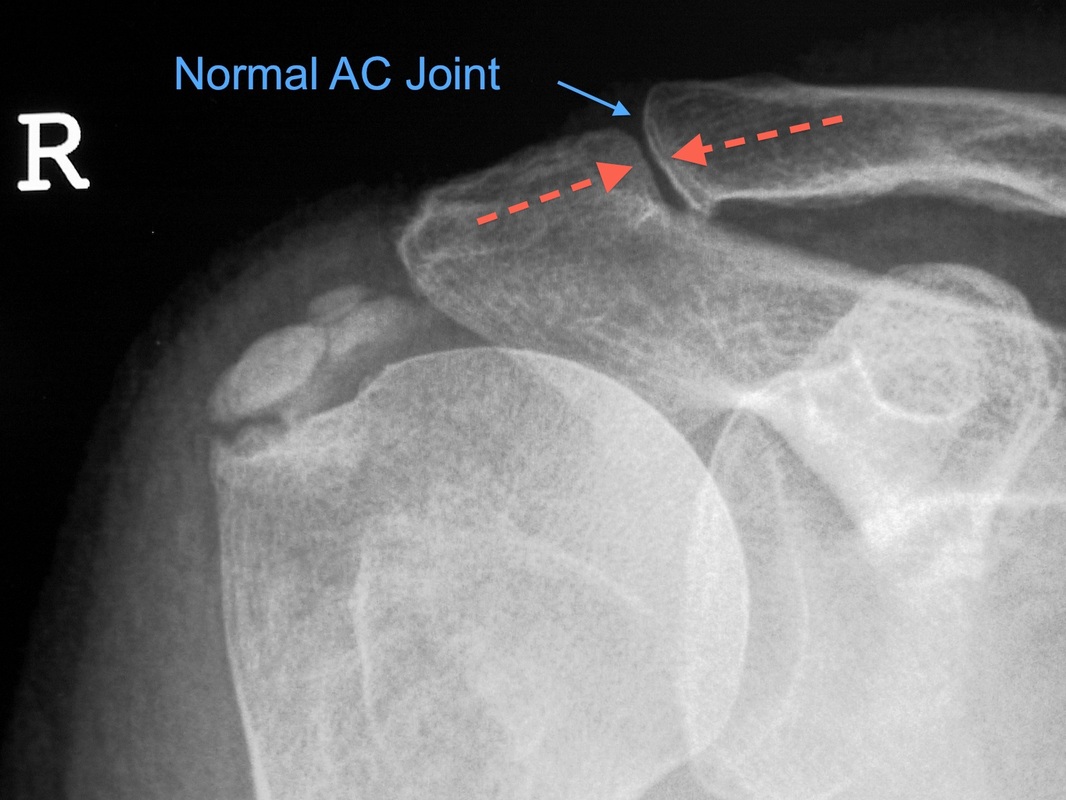Acromio-clavicular Joint Dislocation
The AC joint (acromio-clavicular joint) is the connection between your collar bone and your shoulder blade. The ‘A’ in AC joint comes from the acromion which is part of your shoulder blade and the ‘C’ comes from clavicle which is the correct term for collar bone.
The acromioclavicular joint is situated right at the top of your shoulder underneath where a bra strap or backpack strap would lie.
An acromio-clavicular joint dislocation (also known as a shoulder separation) occurs when the clavicle separates (dislocates) from the acromion. It commonly occurs when you fall directly onto the tip of your shoulder, such as a tackle in football or a fall from a bicycle or skateboard.
The following x-ray demonstrates a normal acromio-clavicular joint on the left and a dislocated acromio-clavicular joint on the right. You can clearly see the clavicle has popped upwards and the joint is now widely separated.
It is important to realise that this is actually a very complex injury. Although it appears the clavicle pops upward it is actually better to think of the whole shoulder blade, with the connected arm, actually dropping downwards. A great deal of soft tissue injury including damage to ligaments occurs with an AC joint dislocation. A patient with this injury will have marked pain at the top of their shoulder and often a swelling in the region.
There is a grading system to determine severity of this injury. It is graded from Grade 1 to Grade 6 in increasing severity. Grade I - 2 injuries are often managed without surgery but Grade 3 – 6 often require surgery. However, this grading system only takes into account the appearance on the x-ray and there are many other factors to consider. These include the age of the patient, time since injury, whether the patient is an overhead athlete, and very importantly, the examination findings to determine how severe the injury is.
If surgery is not required treatment is usually a sling for comfort for the first three to six weeks. The arm is allowed out of the sling for gentle activities of daily living within your pain limits. Gradually you will be able to do more and more and discard the sling after a few weeks. You often will still be left with a slight bump over your shoulder and it can be as long as a year before you can comfortably lie on that shoulder. However, the end result is usually excellent.
If the injury is severe, surgery is required to restore shoulder function. It is quite complex surgery and one or more of the following procedures must be done during the operation.
· Use of an artificial ligament to reconnect the clavicle and shoulder blade.
· Removing a small section at the end of the damaged collar bone.
· Repairing ligaments in and around the AC joint.
· Use of a graft taken from elsewhere in the body.
The following surgical video demonstrates some of the surgical procedures used. In this case the end of the damaged clavicle is resected and an artificial ligament used. Not shown on this video are ligament repairs that would be done at the same time. As mentioned above, an extra graft taken from elsewhere may also be used in this procedure. The exact nature of surgery in each case will depend on the individual situation and the findings at the time of surgery.
Following surgery an extended period of rehabilitation is required. Patients may be required to wear a sling for a large part of the first 4-6 weeks. Overhead use of your arm usually limited initially. You will be able to come out of the sling for showering and for some exercises of your hand, wrist and elbow and you will be able to use your hand for gentle activities at waist level. It is extremely important to be careful in the first few weeks to allow the wound to heal properly.
Any operation involving the AC joint is a serious undertaking. As you can appreciate the clavicle is very close to the skin and for that reason complications such as infection or wound healing problems may occur. Other complications such as implant breakage or even fracture of the bones in the area can also occur. Other complications are detailed in the ‘Complications Section’ of this website.
Due to these complications surgery is only recommended in cases of significant injury and you should not undergo surgery unless you fully understand these risks.
Please contact me if you require further information or an explanation of any part of the surgery.


